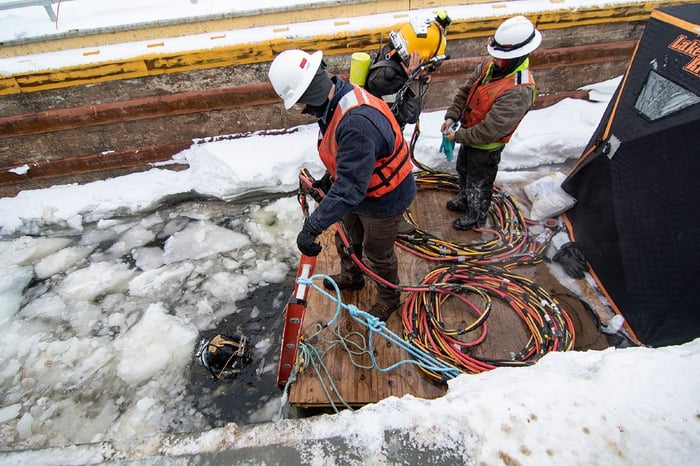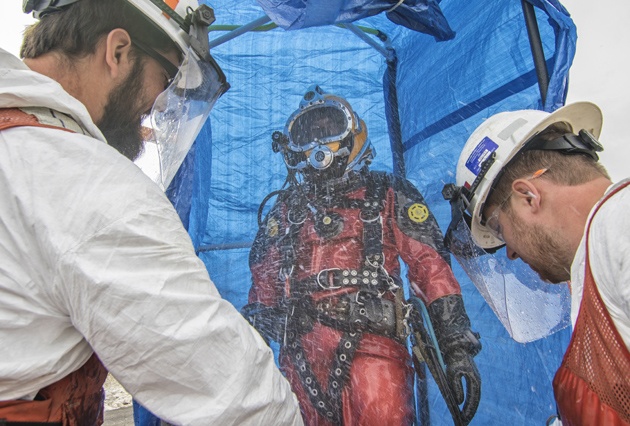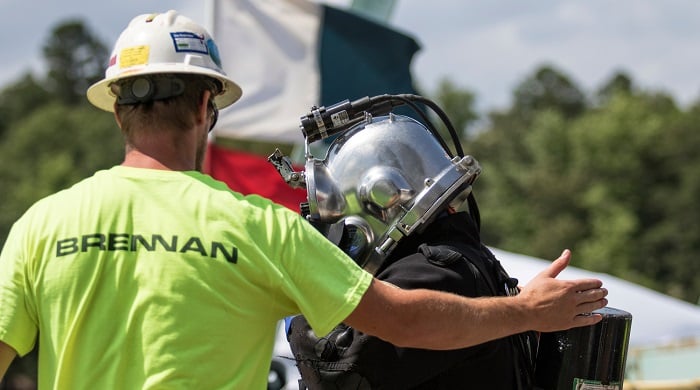Dive teams mobilize every day to complete a broad assortment of tasks utilizing 3‑person dive teams. Historically, this has been the standard not only within Brennan's practices but for most other inland diving organizations. The Association of Diving Contractors International (ADCI) gives guidance that requires, at a minimum, a 3‑person dive team. While this practice is sufficient in some circumstances; such as non-penetration inspections and wheel jobs (propeller repairs); with our growing scope of work it became apparent that a 4‑person dive crew—adding a standby diver—should be our internal minimum standard moving forward.
Defining Dive Team Roles
3-person dive teams are made up of a diver, tender, and supervisor. Being a safety-first company, our leadership moved all dive crews into 4-person teams including a diver, tender, supervisor, and a standby diver. So, what are the roles within a 4-person dive team?
Diver: Our 100+ commercial divers are all ADCI-certified professionals. They work to perform specific tasks, inspections, construction, welding, maintenance, and recovery jobs underneath the waterline.
Tender: The tender is the surface member of the dive team. They work closely with the diver, but will not be underwater. At the start of a dive, the tender checks the diver's equipment and air supply for proper operation.
Supervisor: The diving supervisor is directly responsible for the entire dive operation. They are accountable for team safety and the management of any incidents or accidents that may occur during the dive.
Standby Diver: The fourth member of Brennan's dive team, the standby diver, is available at all times during a dive. They are prepared to assist the primary diver at any moment. Specifically, the standby position is ready to perform a rescue should the diver become stuck or injured.
A real concern, and something we practice throughout the Brennan Dive Group on a regular basis, is the need to rescue an unresponsive diver. While this may seem like a "man-overboard" recovery, the stakes here are actually much higher.
Our process requires a detailed series of events that must happen to successfully recover an affected diver
- Have a standby diver in the immediate area, ready to enter the water at a moments notice.
- Switch breathing air to the backup air source.
- Enter the water in a manner that captures the affected diver’s umbilical so that it can be followed to the diver.
- Capture the diver and insert a pneumofathometer hose into their helmet.
- Secure the affected diver for recovery.
- Have both the standby and affected divers' umbilicals hoisted to the surface in unison.
- At the surface, bring the affected diver onto the diving platform.
- Remove life support equipment from the affected diver.
- Provide first aid.
- Transport the affected diver to the extraction point.
With a 3‑person team, resolving this process efficiently and safely is nearly impossible.

Without a standby diver, the tender becomes the rescue diver and the supervisor is left alone at the surface to carry out all remaining duties. Our work often involves direct interaction with differential pressure (Delta P) environments. These types of projects are the most dangerous for inland divers and provide the greatest chance for a rescue situation. Coupling those complex environments with a heavy workload on a 3-person crew can result in poor performance in emergency or rescue situations. The tender commonly performs general labor tasks and provides tools during a dive project, and the duty of the tender becomes split resulting in a dangerous situation should the diver need assistance or becomes unresponsive.
At Brennan, we pride ourselves on our ability to operate in a safe and productive manner which is why we're choosing to perform dives with 4 team members rather than 3.

Canada’s version of the ADCI—The Divers Certification Board of Canada (DCBC)—has already implemented a 4‑person crew minimum across the board. Although the ADCI has not yet ruled to require a 4‑person minimum for dive teams, Brennan sees the necessity of this change with our growing scope of work. We acted to provide the extra team member for both quality of work and for the safety of all personnel.
Ready for more?
Find out what our Dive Group does during the winter. Getting Work Done When Boats Don't Run: Under-Ice Dive Construction and Inspection.


